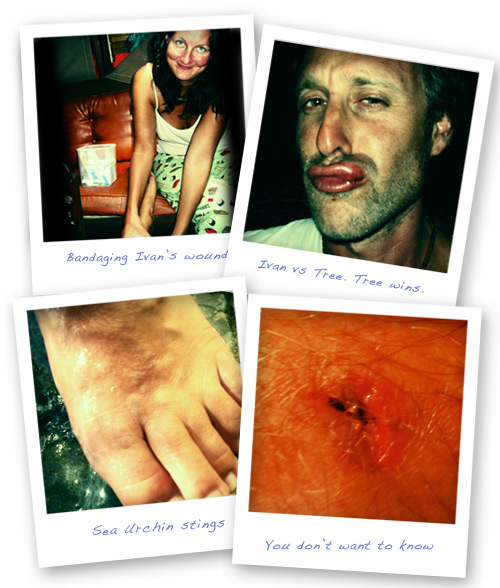Learning to deal with nightmare scenarios in the Wilderness First Responder course. >>
I’m a talented worrier (though I like to call myself a ‘realist’) which means that offshore sailing not only inspires tropical fantasies, but also conjures up fears of worst-case scenarios: a back-breaking tumble, a jibing boom to the skull, a misbehaving organ, an acrobatic shark that jumps on deck and … well, you get the picture. When my partner and I decided to sail the Pacific, I found myself fretting overtime about how we’d cope if there was a medical emergency en route. So I scrawled an item at the top of my pre-departure To-Do list:
1. Obtain a Doctorate in medicine (specializing in trauma injury).
Short on time and money (and, lets face it—intelligence), we decided to do the Wilderness First Responder course (WFR) offered by the Wilderness Medicine Institute—an intensive program that prepares participants for coping with emergencies in remote environments. For 9 days and 80 hours (discounting study), my partner and I became mini-medical students with stethoscopes slung around our necks and medical acronyms rolling off our pompous tongues: “We need to EVAC ASAP—the TBI has caused ICP requiring BLS.”
The course began with rescue breathing, CPR, Heimlich maneuver, and other life-saving skills that I was embarrassed to not already know. We delved into a look at the human body and its functions, learning how to read vital signs to establish a patient’s level of heath. We familiarized ourselves with heart rate, blood pressure, body temperature and respiratory rate by holding instruments to classmates’ arms, necks and chests, getting intimate with strangers in a way that just doesn’t happen in a diesel mechanics class.
From there, we moved into dislocations and broken bones, and while the squeamish cringed, I watched on in fascinated delight as our instructor showed us how to pop a wayward arm back into its socket and realign and splint a broken bone. Employing creativity, we constructed litters from improvised materials (skis, branches, tarp, rope) and learned how to stabilize and move a patient with a neck or back fracture.
The course was so entertaining that I couldn’t wait to get to class in the morning, despite being sleep deprived from the hours of study required of us each night. Delivered in a hands-on format, we wrapped each other in bandages, treated perfectly healthy fellow classmates for an array of pretend ailments and stabbed innocent oranges with epinephrine syringes.
A highlight was being thrown into simulated accident scenes that involved fake blood, vomit, and make-up artistry (our instructor was not only competent in wilderness survival, but was also talented at recreating lacerations and bruising). The props brought the simulation scenes to life so that, with trembling hands, we each had the opportunity to practice our newly acquired skills within the chaos of what felt like a real emergency.
Other key skills learned included:
- Wound management: cleaning and dressing wounds to prevent infection, (particularly vital in the bacteria-loving tropics).
- How to treat a mild, moderate and severe hypothermic or heat stroke victim.
- How to diagnose and treat anaphylactic attack (important for those allergic to bees, jellyfish or other stinging creatures).
- How to put together a comprehensive wilderness first aid kit.
- And, slightly more obscure, yet very entertaining: how to deliver a baby!
Knowing when to call for help was another valuable lesson learned. While a city-based victim will merely irritate the local paramedics by calling 911 for a petty mishap, an evacuation request from a sailor in the middle of nowhere is a much tougher call to make. By reading telltale symptoms and measuring vital signs, it’s possible to determine the difference between, say, a minor knock to the torso, or a life-threatening internal bleed.
Completing this intensive course was empowering. While I can’t perform Hollywood-style tracheotomies with a ballpoint pen, or extract a ruptured appendix with a coconut, a shark’s tooth and some sea urchin juice, I can venture into remove environments and feel armed to cope if the worst should happen.
WFR courses are held throughout the year in various US locations. Price varies depending on location (as a guide, UCLA offers the course for $665). Find out more from www.nols.edu/wmi/courses/wildfirstresponder.shtml
Torre DeRoche is the author of two travel memoirs, Love with a Chance of Drowning (2013) and The Worrier’s Guide to the End of the World (due out September 2017). She has written for The Atlantic, The Guardian Travel, The Sydney Morning Herald, Emirates, and two Lonely Planet anthologies.















53 Response Comments
Nice site, nice and easy on the eyes and great content too.
Thanks!
Valuable info. Lucky me I found your site by accident, I bookmarked it.
Nice looking theme and easy-reading, smart content. Well done! Some kind of air ambulance insurance is worth looking into for people traveling off-soundings or off-road, but readiness for first response is critical, as you note. Great luck with your blog and your book
Thanks, Chip. Did you read about the guy who was rescued 1,400 miles off the US coast? http://coastguardnews.com/coast-guard-and-california-air-national-guard-working–together-in-long-range-medevac/2010/04/01/ He probably had to sell all his working organs to pay for it.
Web Development Wizards https://zetds.seychellesyoga.com/info
Can provide a link mass to your website https://zetds.seychellesyoga.com/info
Your site’s position in the search results https://zetds.seychellesyoga.com/info
Free analysis of your website https://zetds.seychellesyoga.com/info
Content for your website https://zetds.seychellesyoga.com/info
Web Development Wizards https://zetds.seychellesyoga.com/info
Can provide a link mass to your website https://zetds.seychellesyoga.com/info
Your site’s position in the search results https://zetds.seychellesyoga.com/info
I offer mutually beneficial cooperation https://zetds.seychellesyoga.com/info
Cool website. There is a suggestion https://zetds.seychellesyoga.com/info
I really liked your site. Do you mind https://zetds.seychellesyoga.com/info
Here’s what I can offer for the near future https://zetds.seychellesyoga.com/info
Content for your website https://ztd.bardou.online/adm
Free analysis of your website https://ztd.bardou.online/adm
SEO Optimizers Team https://ztd.bardou.online/adm
Cool website. There is a suggestion https://ztd.bardou.online/adm
Content for your website https://ztd.bardou.online/adm
Web Development Wizards https://ztd.bardou.online/adm
Can provide a link mass to your website https://ztd.bardou.online/adm
Free analysis of your website https://ztd.bardou.online/adm
I offer mutually beneficial cooperation https://ztd.bardou.online/adm
Cool website. There is a suggestion https://ztd.bardou.online/adm
Your site’s position in the search results http://myngirls.online/
Free analysis of your website http://myngirls.online/
SEO Optimizers Team http://myngirls.online/
I offer mutually beneficial cooperation http://myngirls.online/
Content for your website http://fertus.shop/info/
Web Development Wizards http://fertus.shop/info/
Free analysis of your website http://fertus.shop/info/
SEO Optimizers Team http://fertus.shop/info/
I offer mutually beneficial cooperation http://fertus.shop/info/
Cool website. There is a suggestion http://fertus.shop/info/
I really liked your site. Do you mind http://fertus.shop/info/
Here’s what I can offer for the near future http://fertus.shop/info/
The best prices from the best providers http://fertus.shop/info/
Additional earnings on your website http://fertus.shop/info/
Analytics of your website http://fertus.shop/info/
I would like to post an article http://fertus.shop/info/
Shall we exchange links? My website http://fertus.shop/info/
The offer is still valid. Details http://fertus.shop/info/
We offer cooperation on SEO optimization http://fertus.shop/info/
Content for your website http://fertus.shop/info/
Web Development Wizards http://fertus.shop/info/
Can provide a link mass to your website http://fertus.shop/info/
Web Development Wizards http://fertus.shop/info/
Your site’s position in the search results http://fertus.shop/info/
Great article! I found your perspective on this topic both enlightening and thought-provoking. The way you break down complex ideas into understandable insights is truly commendable. It’s interesting to see how these developments could shape our future. I’m particularly intrigued by your point about potential challenges and would love to dive deeper into that.
For those who are interested in exploring this topic further, I recommend checking out this resource for more detailed information: comprehensive guide. It offers additional insights that complement what’s discussed here.
Looking forward to hearing others’ thoughts and continuing this discussion. Thanks for sharing such valuable information!